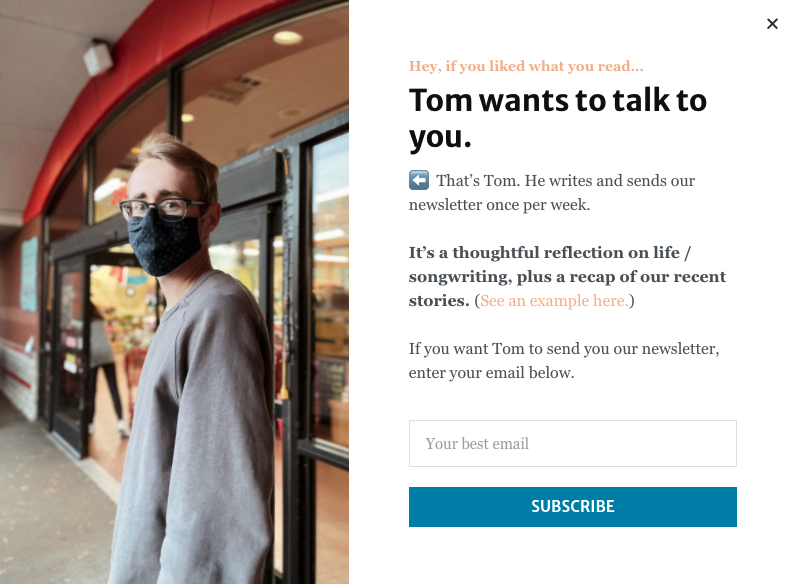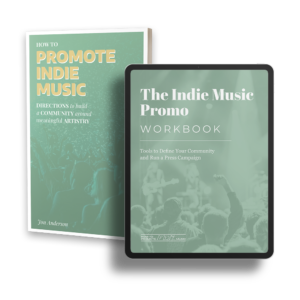Welcome to this week’s email!
…It’s going to be about email.
Because I’ve been talking with a bunch of artists about email lists lately. And because I’ve shared a bunch of random personal things over the past month, and I figure it’s time to write about something practical.
I think email is very practical.
Okay, here we go: five tips on email lists, delivered marketing-blog-post style, but hopefully slightly less boring and slightly more helpful.
1. Start an email list if you haven’t yet.
It all starts with starting. And I’ve got three reasons why you should:
A) An email list is one of the best ways to encourage action / engagement.
Email’s inherently a deeper relationship than social media because, rather than being initiated by a drive-by, mean-nothing click, it’s initiated by a sacrifice.
A person gives up their email address.
Because it’s a deeper relationship, it’s more likely to lead to action. You’ll be able to sell tickets, merch, etc. more easily via email than on most other channels.
I think it tends to be a more meaningful channel, too.
B) Unlike a social following, an email list is yours.
Tik Tok or Instagram could change their algorithm tomorrow, and smart money says they probably will.
Email is unchanging. Email is independent. Email is immortal!
Ha, sorry, those things aren’t true. Email changes. Google and Apple have a lot of power and can totally screw things up if they want. They worked on doing that last year.
But still, email is more independent and has a more consistent track record than any social media network.
Plus your subscribers really are yours.
C) It’s free (at least at first).
MailChimp is free up to 2,000 subscribers. ConvertKit is free up to 300 subscribers. Sendinblue is free as long as you don’t send more than 300 emails per day.
Basically any of those platforms (or the tons of others that I didn’t mention) will give you the tools you need to do simple things that I’ll outline below, like send a newsletter, segment your list, or create a workflow.
No cost = totally worth it. Don’t deliberate about which tool to use; just get started.
2. Bring your list sign-up form to the top of your website.
Boring-practical tip: Too many artists have their email signup form buried in the footer of their website.
You know who scrolls to the footer of a website?
Me.
I do it so I can condescendingly roll my eyes and go, “Ah, I see they’ve got their email signup in the footer of their website. I bet their conversion rate is below 1%.”
(Yeah I’m annoying even to myself.)
Other than that, nobody.
That’s why if you look at any site that’s been “optimized for conversion” (which is marketing-speak for “designed to get customers / subscribers”), you’ll almost definitely see a button or an email signup form before you have to scroll down the page at all.
I’d recommend having your signup form here (not sure what it looks like on mobile, but on desktop she has a banner that follows you).
Basically, just don’t put it in the footer.
Also, I recommend adding something personal to the call-to-action (the text that encourages people to sign up).
A lot of sites have the word “Subscribe” but don’t give much of an incentive to follow the command.
Write what you’d honestly tell a friend if you were asking them to sign up. For example, here’s my current CTA for the Two Story Melody newsletter:

About twenty people sign up for that each week. It’d probably be more if Tom was better looking.
Totally kidding, Tom, totally kidding. You’re handsome.
But seriously I’m going to A/B test this with Tom Holland and see what happens.
3. Create a “Welcome Series” and have it sent to everyone who signs up.
Okay, so let’s say that a) you’ve got an email list and b) people are signing up for it. Here’s the next step: Create a welcome series that’s automatically sent when people sign up.
Automated series are great because they let you connect in more depth… automatically.
The specific buttons you push to make this happen vary depending on what system you’re using, but pretty much every system has the buttons, and they’re almost always easy to push.
Here’s what I’d recommend:
- Write three emails.
- In the first email, thank people for subscribing to your list. In the second email, tell your story / share your background. In the third email, tell people how they can get involved with you (i.e. link to your shows page or your merch store).
- Set up each email to send a couple of days apart.
Bam – you’re now an email marketer, and you’re on your way to the holy grail of online business: passive income. All you have to do is sell 33,334 30-dollar t-shirts and you’ll be a millionaire.
(In reality, you won’t see much income from this unless you’re really blowing up. But if you keep plugging away, you should see a small drip.)
4. Sign up for newsletters from your favorite artists.
When I worked in B2B technology marketing, my company made new employees sign up for five B2B tech marketing newsletters so that we’d get an idea of what the industry was doing.
The same thing works for music marketing. By signing up for emails, you’ll get familiar with how emails work.
And signing up for emails from musicians is a lot more fun.
Generally.
To be transparent – and probably obvious – some lists are either inactive or lame (meaning they just blast promotions). But there are a ton of good ones out there, too, that’ll give you ideas for your own.
5. Write a newsletter at least once a month.
In email marketing, as in pretty much all things, consistency wins the day.
You’ll tend to get more value from your list the more time / effort you put into it. But I’d say the minimum you should shoot for is one send per month.
“But what should I write about?” you wonder.
Ah same. I ask myself that every time I sit down to write one of these dang things. Some weeks I think I’ve got it planned out, only to start typing and watch something different and weirdly personal emerge.
Here’s my take: It actually doesn’t matter that much what you write about.
You’re an artist. People probably aren’t on your list for specific thoughts on specific topics. They’re probably not even on it for updates on your releases.
They’re on it for you.
I’ve heard it said you should accentuate your personality when you write. I’m kind of onboard with that, but I like the version more where you just write like you’re talking to a friend. Share your personality. Share stories. Go off on a rant about something.
Friendships are impacted by what you talk about, but they’re founded on the simple fact that you’re talking.
So write. Real relationships can come from it.
(Okay if you really need a prompt, answer the question “What happened with my music last month?” and the question “What do I have planned with my music this month?”)
All right, final thoughts…
I want to add a caveat: As much as I love it, the truth is that email isn’t the best time investment for every artist.
If you enjoy Tik Tok way more, then you’re probably better served spending time there. If you hate to write, you’re probably not going to love email.
But I do think, in most cases, email is very much worth the investment.
So, there you go. I hope some of this was helpful, I hope it’s not overwhelming, and I hope you find some success with it.
Or, better yet, connection.

